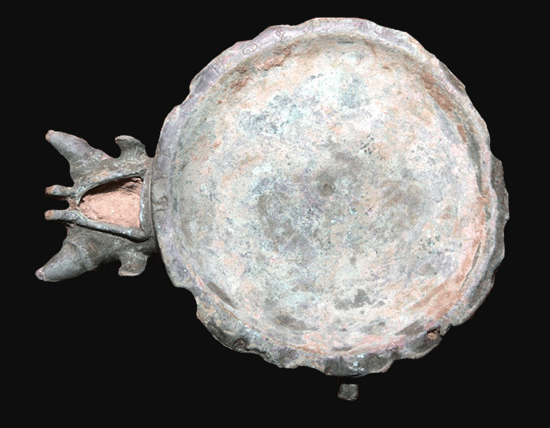Sabean Bronze Incense Stand with Inscription, 500 BCE - 100 BCE
Bronze
15.2 x 19.1 cm
6 x 7 1/2 in
6 x 7 1/2 in
SK.055
The production and export of incense was a vital part of the economy of ancient Yemen. Large numbers of incense burners and stands have been excavated which display an extraordinary...
The production and export of incense was a vital part of the economy of ancient Yemen. Large numbers of incense burners and stands have been excavated which display an extraordinary variety of shape and form, reflecting the importance of incense within local society. Metal burners were undoubtedly the most costly but the majority that survive are made of stone or pottery. Local aromatics included frankincense and myrrh and were famous across the Mediterranean and Near Eastern world. In 450 BC, for example, the Greek historian Herodotus remarked, ‘Arabia is the only the place that produces frankincense, myrrh, cassia, cinnamon and the gum called ledanon…the whole country exhales a more than earthly fragrance.’
This exceptional bronze sculpture was probably used as a stand to hold an incense burner. The neck is cylindrical with a wide narrow band above a flared base. The circular platform has a ridged exterior from which protrudes a spectacular bull head. The bulging eyes, wide nostrils and short ears are all portrayed with great naturalism. There are rings between the horns and around the upper body, the exact purpose of which is still unclear. A stand of this quality would have been a luxury item, perhaps donated to a temple or interred in a richly furnished tomb. Surviving incense burners are often inscribed and this example is no exception. The text on the neck may refer to the previous owner, record a dedication or even the name of a particular type of incense. This is an extremely rare and fascinating survival.
For Sabean incense burners in general see St John Simpson ed., ‘Queen of Sheba: Treasures from Ancient Yemen,’ (British Museum, 2002), pp. 95-98, p. 207.
This exceptional bronze sculpture was probably used as a stand to hold an incense burner. The neck is cylindrical with a wide narrow band above a flared base. The circular platform has a ridged exterior from which protrudes a spectacular bull head. The bulging eyes, wide nostrils and short ears are all portrayed with great naturalism. There are rings between the horns and around the upper body, the exact purpose of which is still unclear. A stand of this quality would have been a luxury item, perhaps donated to a temple or interred in a richly furnished tomb. Surviving incense burners are often inscribed and this example is no exception. The text on the neck may refer to the previous owner, record a dedication or even the name of a particular type of incense. This is an extremely rare and fascinating survival.
For Sabean incense burners in general see St John Simpson ed., ‘Queen of Sheba: Treasures from Ancient Yemen,’ (British Museum, 2002), pp. 95-98, p. 207.



